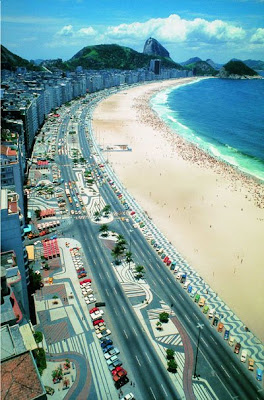Roberto Burle Marx and his Wave Pattern
On June 8, 2019 the NY Botanical Garden will open their new exhibit dedicated to Roberto Burle Marx! I visited it this week in a preview and it is spectacular! You have to see it - #plantlove
 |
| The centerpiece of Burle Marx show at #NYBG |
I wrote this a few years ago and feel it is the perfect time to share this post again:
Roberto Burle Marx
I loved that Burle Marx painted every morning before attending to his design practice and that he said he 'painted his gardens'.
tablecloth design by Burle Marx
He also asserted that the creation of a garden was 'an attempt to regain a lost paradise'. I could not agree more!
Flamengo park
Burle Marx's grasp of pattern was one of his signature features. His bold use of color and shape captured the Brazilian culture masterfully and made them pertinent to the twentieth century.
Burle Marx's designs are intimately linked with the Modernist style and Brazil's national identity; his lyrical landscapes have indeed become synonymous with the modern image of Brazil.
He had a painter’s eye and a superb sense of composition and form. In 1965 the American Institute of Architects (AIA) awarded Burle Marx its fine-arts prize, calling him 'the real creator of the modern garden'.
In 1991, the Museum of Modern Art in New York held their first exhibition dedicated to a landscape architect.
Ministry of Health and Education roof garden, Rio de Janeiro,1938
Burle Marx not only explored ideas through a variety of artistic media such as painting and etching he was also an expert horticulturist with several species named after him.
He collected more than 3,500 different species, and grew, studied and multiplied the plants he used in his projects.
His painterly gardens led to his assignment as the designer of the celebrated mosaic pavements along Copacabana beach in Rio de Janeiro.
The Copacabana promenade was completed in 1972 and used a black and white geometric wave originally introduced in the early 1900s by Portuguese artisans using patterns typical of Portuguese walkways.
Rossio Square in Lisbon
Rossio Square in Lisbon
It was this blending of art and craft, plants and pavement, old and new, and artifice and nature that made Roberto Burle Marx the giant that he was.
Photograph source: Escritório Burle Marx





















ReplyDeleteSeeing the photo of Flamingo Park, I can't help but think of the rose garden designed by Fletcher Steele at Naumkeag. Are the dates roughly similar? Is there more than congruity of time that makes these two designs so similar?
I think you are right - that wavy design....
Delete